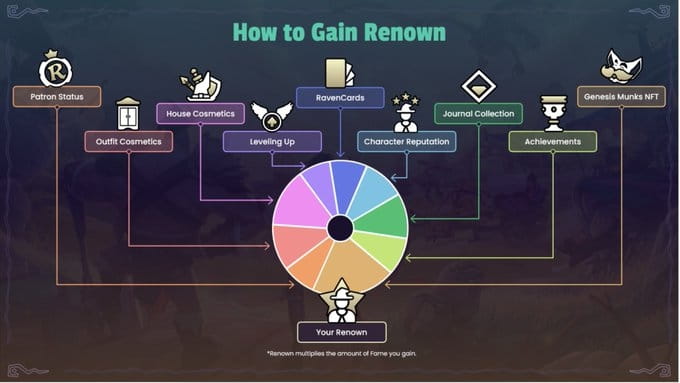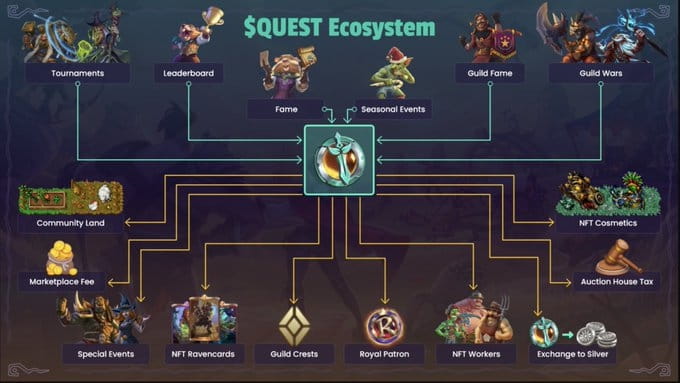#web3gaming #web2game #BCG #鏈分天下 #鏈遊爭霸
Veterans have previously mentioned that 2025 will be the battle between IMX's Raven Quest and AVAX's Maple Story U.
What special aspects do they have in terms of web 3 attributes, specifically economic models, that can lead to a top battle?
This article will first explore Raven Quest:
1) Free to Play, Play to Earn.
The project team has put a lot of thought into the economic model from the initial design of this MMORPG, and has studied, practiced, and improved it over 7 years in web 2. Therefore, the issues and impacts (shocks) generated when transitioning to web 3 will naturally be relatively fewer compared to other projects (although it is not possible to have no issues at all).
In Raven Quest, although items/assets are not all NFTs/on-chain like in Maple Story/Lumiterra, the silver coins can be directly exchanged for $Quest, which means that all items in the game can also be considered as being on-chain. Of course, when the game officially launches, the exchange rate of silver coins to $Quest (should be floating) and whether there are restrictions on exchange conditions are not specified in the current white paper. This will be of utmost concern to 'non-paying' or 'freemium' players. Under normal logic, this type of free-to-play game can achieve free-to-earn, but to what extent can they earn? It should be very minimal. However, for web 3 MMO games, free-to-play/non-paying existence is essential. Because they serve as the basis and entry threshold for converting into paying players or long-term invested players. Therefore, this is a very good setting for the future growth rate of the player base.
2) Web 2 and Web 3 payment parallel mechanism.

The game itself has transitioned from web 2 to web 3, so it will still retain payment attributes, which will be very familiar to web 2 players. The project team has stated in the white paper that the revenue earned from web 2 will also be invested in repurchasing $Quest and expanding the development of the web 3 ecosystem. (This mechanism has already been clearly validated in BigTime.)
Web 2 and Web 3 will each have different shops, with different items available for purchase that can enhance various abilities and experiences. Players will not be able to rely solely on one shop to improve their strength in the game. It seems that appropriate spending is still necessary.
There will also be mechanisms like monthly cards - Patron, retaining the flavor of past web 2.
3) Web 3 game contribution reward mechanism.
The game will have 'regular' or 'quarterly' events to provide $Quest airdrops as incentives.
These incentives are combined through 'personal honor' - Renown and 'fame' - Fame to form the 'total game fame' - Total Fame, which serves as the basis for airdrops.
Renown is a coefficient that does not reset, calculated based on the player's level of engagement in the game (such as level, spending amount, number of NFTs, achievements, main storyline completion, etc.) as a combined coefficient.
Fame is obtained through events, various types of leaderboards, guild battles, etc. It resets after each quarter/event.
Total Fame is derived from Fame x Renown and serves as the indicator for the airdrop mechanism.

This Renown coefficient setting balances the differences in airdrop earnings between new players and veterans during each season/special event. (In other words, veteran players/NFT holders won't receive substantial airdrops just for spending a long time in the game without actively participating in events/games.)

NFTs in the game are targeted, such as LAND being production-oriented, RavenCards being PVP combat-oriented, and Cosmetics being focused on personal enjoyment. There won't be a situation where being a big spender grants overwhelming power or possessing many NFTs guarantees long-term airdrop benefits.
Therefore, the focus will still be on playing the 'game'. (In other words: effort is key.)
4) The depth of the game's story and the breadth of professions and living systems.
Many web 3 players may compare Lumiterra with Raven Quest, wondering why players prefer the older visual style of Raven Quest despite the 'similar' games/economic models.
The depth of the game's story and the breadth of professions and living systems determines everything!
Veterans have previously mentioned that this is what Lumiterra has always lacked. Especially for players from the original pyramid model (where non-paying base players supply materials to upper-level players for profit). Due to insufficient depth and breadth, the originally designed economic ladder was distorted, even collapsed. Players quickly find the optimal solution for returning or making money, leading to all players rushing to do the same thing for arbitrage. Additionally, without systemic incentives for upper-level players, PVP becomes extremely severe, causing assets in the market to collapse due to supply-demand imbalance.
In Raven Quest, however, because of the depth of the story, and the support of different professions and life skills, players can be dispersed across different levels of the ladder. Coupled with system limitations on the number of professions that can be simultaneously trained, it creates an ecosystem that requires interdependence (i.e., a player cannot be completely self-sufficient; trading between players is necessary to achieve certain goals or enhance abilities/equipment), making it less likely for the in-game economy to collapse easily.
Guilds, guild battles, and PVP area mechanisms will also bring healthy competition and a pursuit of power in the game.
Unlike Lumiterra, where the large map limits make PVP gameplay very unfriendly to lone wolves/non-paying players, forcing them to leave the game.
5) Potential issues.
Like other gamefi/web 3 games, a single currency economy will make the only arbitrage currency a target for selling. The currency usually rises in the early stages of the game due to players needing to upgrade various gear, abilities, etc. Once the quarterly airdrop ends, arbitrage can lead to a significant drop. If the amount bought is less than that being arbitraged, the currency will experience a situation where it only drops and does not rise.
Although web 2 income can be used to pump the price, the game operates on a mechanism of buying $Quest to earn $Quest. As the number of fully invested players accumulates, the selling pressure on $Quest will only increase. How will the project team address this situation in the future? We will have to see how the game operates moving forward.
In fact, as long as the pool is large enough and the time difference between buying and selling is extended, by running various activities and season events, allowing new funds and players to join, having inflows and outflows, it is not difficult to sustain long-term survival. So we will have to see the project team's operational methods.

However, if web 2 can survive for 7 years, then there is really not much to worry about for web 3.
If you want to know more about the game's strategies, you can refer to Huka Bros' RavenQuest beginner's guide:
https://link.medium.com/1D7g0RBr3Qb
And the official white paper: https://whitepaper.ravenquest.io
Looking forward to the global launch on March 14.
The above are not investment insights, just a veteran's idle chatter.
Web 3 gaming, DYOR, TYOR.
Veteran out.